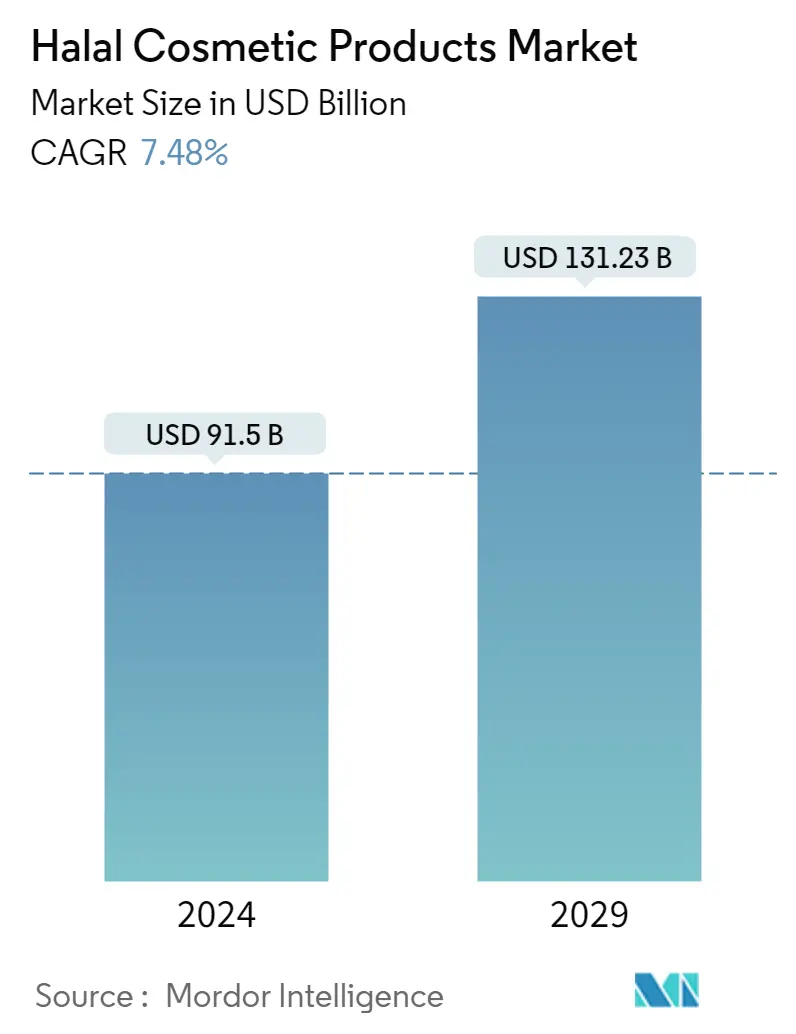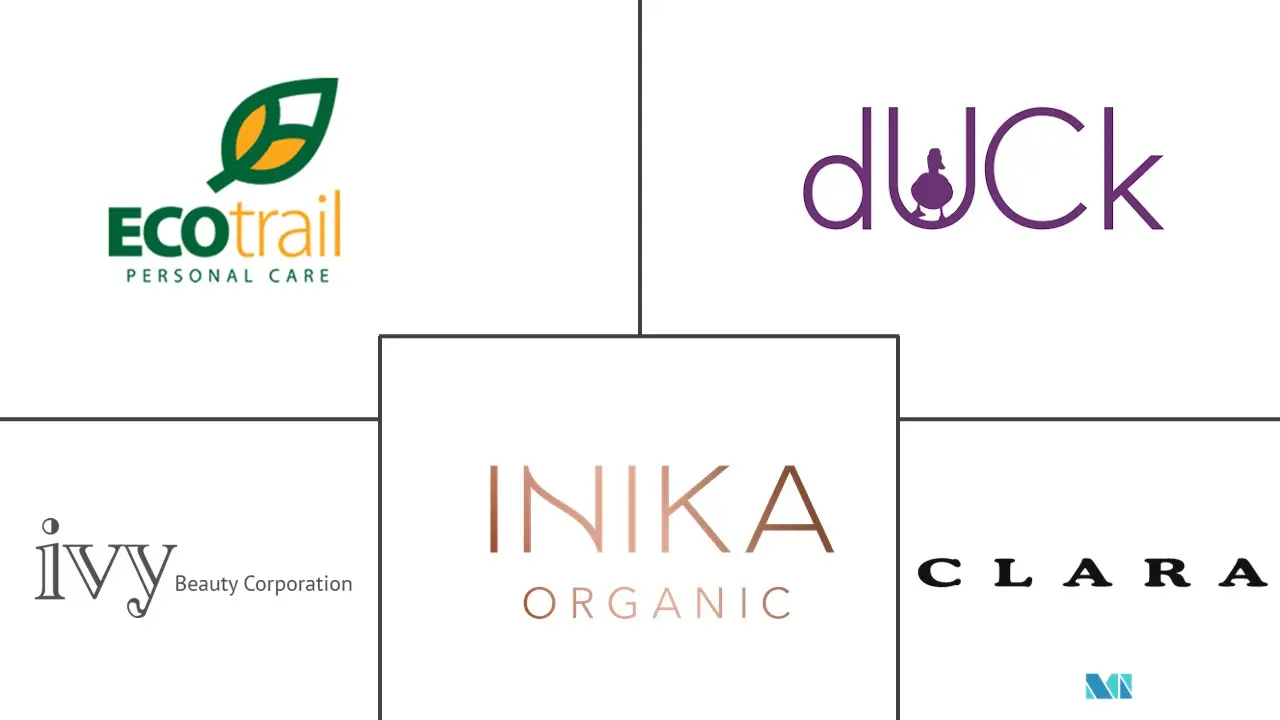Market Size of Halal Cosmetic Products Industry

| Study Period | 2018 - 2029 |
| Market Size (2024) | USD 91.50 Billion |
| Market Size (2029) | USD 131.23 Billion |
| CAGR (2024 - 2029) | 7.48 % |
| Fastest Growing Market | Europe |
| Largest Market | Middle East and Africa |
| Market Concentration | Low |
Major Players
*Disclaimer: Major Players sorted in no particular order |
Halal Cosmetic Products Market Analysis
The Halal Cosmetic Products Market size is estimated at USD 91.5 billion in 2024, and is expected to reach USD 131.23 billion by 2029, growing at a CAGR of 7.48% during the forecast period (2024-2029).
The pandemic has created opportunities for new product lines such as creams, face creams, eye care, and sanitizers. The outbreak has modified consumer demand for above-the-mask products such as eye care, eye makeup, hand creams, face creams, and others. Most of the traditional markets across the globe are getting saturated. However, the Muslim community is developing fast-growing consumer products and segments worldwide. One of these most promising segments witnessing the fastest growth in recent years is the halal cosmetics products market. This segment offers a key growth opportunity for personal care and cosmetics manufacturers worldwide. For instance, in June 2021, the skin care company Flora & Noor introduced a line of halal skin care. The company offers body products like body butter, scrubs, and bath bombs, in addition to cleansers, toners, serums, moisturizers, and masks. Flora & Noor is available at floraandnoor.com, Walmart.com, Amazon, and Miiriya.
Color cosmetic products are growing at the fastest growth rate in the global halal cosmetic products market, attributable to the increasing number of young Muslim population associating their lifestyle and appearance with Islamic rules. In the range of halal cosmetics, regulations for cosmetics do not directly or indirectly affect the average user to participate in religious rituals. They are free from animal cruelty, caring for the environment, not harming one's body (eating natural formulations, organically grown products, and those free from pesticides or ingredients deemed harmful to the body), and fulfilling corporate social responsibility (which includes fair trade and no exploitation of workers).
Halal Cosmetic Products Industry Segmentation
Halal cosmetic products must not contain any of the following: alcohol, human parts, ingredients thereof, or animals prohibited for consumption by Muslims. The global halal cosmetic products market is segmented into product type, distribution channel, and geography. By product type, the market is segmented into skincare, haircare, color cosmetic, and fragrances. By distribution channel, the market is segmented into supermarkets/hypermarkets, specialty stores, convenience stores, online retail stores, and other distribution channels. The report analyzes emerging and established economies across the globe, comprising North America, Europe, Asia-Pacific, South America, and Middle East & Africa. For each segment, the market sizing and forecasts have been done based on value (in USD million).
| Product Type | |
| Skin Care | |
| Hair Care | |
| Color Cosmetics | |
| Fragrances |
| Distribution Channel | |
| Supermarkets/Hypermarkets | |
| Specialty Stores | |
| Convenience Stores | |
| Online Retail Stores | |
| Other Distribi |
| Geography | |||||||||
| |||||||||
| |||||||||
| |||||||||
| |||||||||
|
Halal Cosmetic Products Market Size Summary
The halal cosmetic products market is experiencing significant growth, driven by the increasing demand for personal care and beauty products that align with Islamic principles. This market segment is gaining traction as consumers, particularly within the young Muslim demographic, seek products that are free from animal cruelty and harmful ingredients, while also adhering to their religious beliefs. The pandemic has further accelerated this trend, with new product lines such as creams and sanitizers gaining popularity. The market is witnessing a surge in color cosmetics, as young Muslims associate their lifestyle and appearance with Islamic rules. This has opened up lucrative opportunities for personal care and cosmetics manufacturers globally, with companies like Flora & Noor and Mikyajy expanding their offerings to cater to this demand.
The Middle East region, particularly countries like Saudi Arabia and the United Arab Emirates, is emerging as a key market for halal cosmetics due to its large Muslim population and high consumer spending on personal appearance. The demand for halal-certified products is prompting global brands and online retailers to expand their presence in this region. The establishment of companies like the Halal Products Development Company in Saudi Arabia underscores the growing importance of halal cosmetics. The competitive landscape is marked by the presence of both domestic and international players, with companies such as INIKA Organic and IVY Beauty Corporation adopting strategies like product launches and geographical expansions to capture market share. Partnerships and investments, such as Iba Cosmetics' collaboration with Believe Company, are further driving the market's growth across regions like the Middle East, Europe, and South Asia.
Halal Cosmetic Products Market Size - Table of Contents
-
1. MARKET DYNAMICS
-
1.1 Market Drivers
-
1.2 Market Restraints
-
1.3 Porter's Five Forces Analysis
-
1.3.1 Threat of New Entrants
-
1.3.2 Bargaining Power of Buyers/Consumers
-
1.3.3 Bargaining Power of Suppliers
-
1.3.4 Threat of Substitute Products
-
1.3.5 Intensity of Competitive Rivalry
-
-
-
2. MARKET SEGMENTATION
-
2.1 Product Type
-
2.1.1 Skin Care
-
2.1.2 Hair Care
-
2.1.3 Color Cosmetics
-
2.1.4 Fragrances
-
-
2.2 Distribution Channel
-
2.2.1 Supermarkets/Hypermarkets
-
2.2.2 Specialty Stores
-
2.2.3 Convenience Stores
-
2.2.4 Online Retail Stores
-
2.2.5 Other Distribi
-
-
2.3 Geography
-
2.3.1 North America
-
2.3.1.1 United States
-
2.3.1.2 Canada
-
2.3.1.3 Mexico
-
2.3.1.4 Rest of North America
-
-
2.3.2 Europe
-
2.3.2.1 Germany
-
2.3.2.2 United Kingdom
-
2.3.2.3 France
-
2.3.2.4 Russia
-
2.3.2.5 Spain
-
2.3.2.6 Italy
-
2.3.2.7 Rest of Europe
-
-
2.3.3 Asia-Pacific
-
2.3.3.1 China
-
2.3.3.2 Japan
-
2.3.3.3 India
-
2.3.3.4 Australia
-
2.3.3.5 Rest of Asia-Pacific
-
-
2.3.4 South America
-
2.3.4.1 Brazil
-
2.3.4.2 Argentina
-
2.3.4.3 Rest of South America
-
-
2.3.5 Middle-East and Africa
-
2.3.5.1 South Africa
-
2.3.5.2 Saudi Arabia
-
2.3.5.3 Rest of Middle-East and Africa
-
-
-
Halal Cosmetic Products Market Size FAQs
How big is the Halal Cosmetic Products Market?
The Halal Cosmetic Products Market size is expected to reach USD 91.50 billion in 2024 and grow at a CAGR of 7.48% to reach USD 131.23 billion by 2029.
What is the current Halal Cosmetic Products Market size?
In 2024, the Halal Cosmetic Products Market size is expected to reach USD 91.50 billion.

